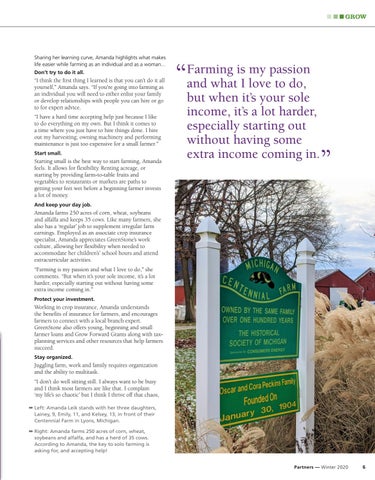GROW
Sharing her learning curve, Amanda highlights what makes life easier while farming as an individual and as a woman... Don’t try to do it all.
“I think the first thing I learned is that you can’t do it all yourself,” Amanda says. “If you’re going into farming as an individual you will need to either enlist your family or develop relationships with people you can hire or go to for expert advice. “I have a hard time accepting help just because I like to do everything on my own. But I think it comes to a time where you just have to hire things done. I hire out my harvesting; owning machinery and performing maintenance is just too expensive for a small farmer.” Start small.
Starting small is the best way to start farming, Amanda feels. It allows for flexibility. Renting acreage, or starting by providing farm-to-table fruits and vegetables to restaurants or markets are paths to getting your feet wet before a beginning farmer invests a lot of money.
“
Farming is my passion and what I love to do, but when it’s your sole income, it’s a lot harder, especially starting out without having some extra income coming in.
”
And keep your day job.
Amanda farms 250 acres of corn, wheat, soybeans and alfalfa and keeps 35 cows. Like many farmers, she also has a ‘regular’ job to supplement irregular farm earnings. Employed as an associate crop insurance specialist, Amanda appreciates GreenStone’s work culture, allowing her flexibility when needed to accommodate her children’s’ school hours and attend extracurricular activities. “Farming is my passion and what I love to do,” she comments. “But when it’s your sole income, it’s a lot harder, especially starting out without having some extra income coming in.” Protect your investment.
Working in crop insurance, Amanda understands the benefits of insurance for farmers, and encourages farmers to connect with a local branch expert. GreenStone also offers young, beginning and small farmer loans and Grow Forward Grants along with taxplanning services and other resources that help farmers succeed. Stay organized.
Juggling farm, work and family requires organization and the ability to multitask. “I don’t do well sitting still. I always want to be busy and I think most farmers are like that. I complain ‘my life’s so chaotic’ but I think I thrive off that chaos, ➡ Left: Amanda Leik stands with her three daughters, Lainey, 9, Emily, 11, and Kelsey, 13, in front of their Centennial Farm in Lyons, Michigan. ➡ Right: Amanda farms 250 acres of corn, wheat, soybeans and alfalfa, and has a herd of 35 cows. According to Amanda, the key to solo farming is asking for, and accepting help!
Partners — Winter 2020
6
